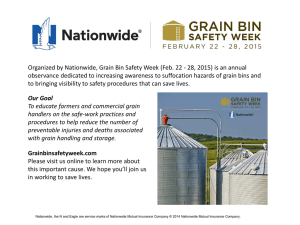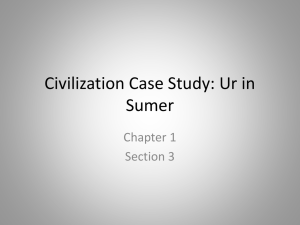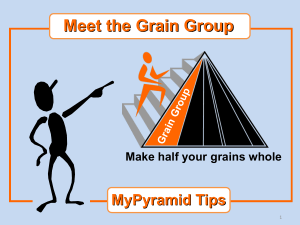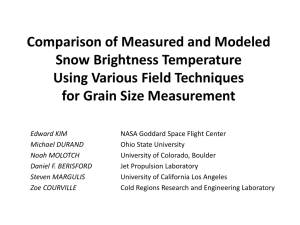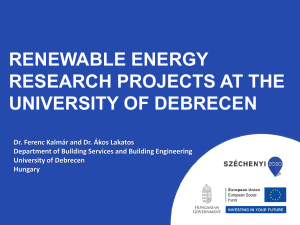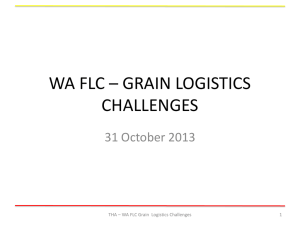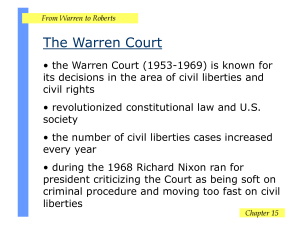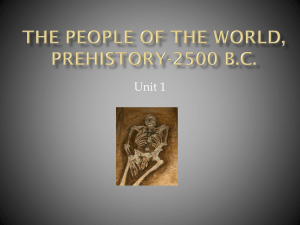关于Roberts Farming (2)
advertisement
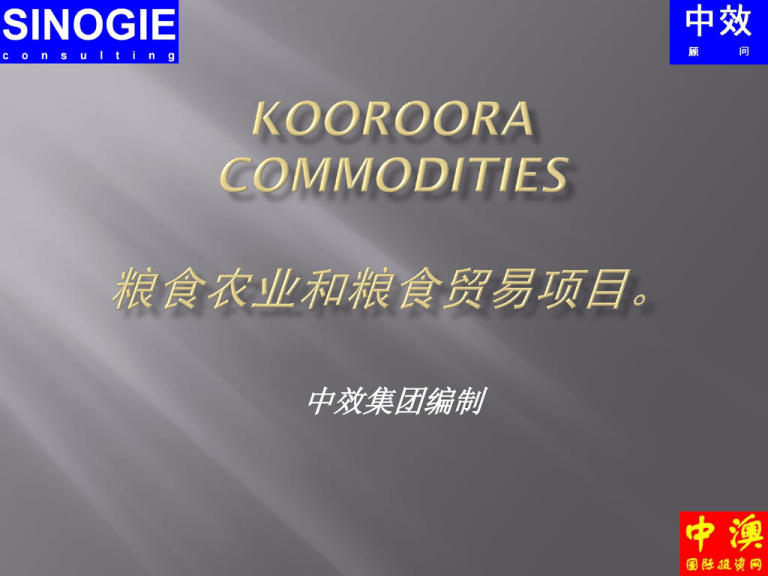
中效集团编制 Pre-NDA presentation (English) Prepared by Sinogie Consulting Group 这是一个极好的投资机会。这个项目将能够确保每年提 供40,000吨或更多的小麦,并且以比目前低的多的价格 提供给中国。 我们已经确定了毛利率约为31美元/每吨:这相当于每 年124万美元的毛利,净资产收益率将在10%左右。 中国的投资者有能力直接销售这些小麦给中国的终端用 户将进一步增加利润。 This is an opportunity to invest in a project which will be able to secure 40,000 tonnes of wheat or more per year, and deliver it to China at far lower prices than are currently possible. We have identified a gross margin of approximately US$ 31 per tonne: this equates to a gross profit of US$ 1.24 million per year, or an ROE of around 10%. A Chinese investor with the ability to sell wheat directly to Chinese end-users would be able to further increase this margin. 我们的客户(Roberts Farming) 经营一个靠近新南威尔士州(“新州”) 达博的庞大农场已经有60年的历史。 投资者将把Kooroora Commodities的股权划分为一个新的实体。 Kooroora Commodities将由Roberts Farming拥有一部分,另外的部分将由一 个或更多的中国投资者拥有。 Kooroora Commodities的价值将在1,400万澳元。 Roberts Farming将保持Kooroora Commodities中48%的股权。 我们需要投资740万澳元来获得Kooroora Commodities中52%的股权。这可以由一个 投资者投资740万澳元或由两个投资者各出370万澳元来各自获得26%的股权。 单独投资370万澳元并投资130万澳元的新南威尔士州政府债券可能将有资格获得显著 投资人签证。 这些数字是可以商量的。 Our client (Roberts Farming) has operated a large wheat farm close to Dubbo, NSW, for 60 years. The investor would be taking a stake in a new entity, Kooroora Commodities. Kooroora Commodities will be part owned by Roberts Farming, and part owned by one or more Chinese investors. Kooroora Commodities will be valued at A$ 14 million. Roberts Farming will maintain a 48% stake in Kooroora Commodities. We need an investment of A$ 7.4 million for a 52% stake in Kooroora Commodities. This could come from one investor with A$ 7.4 million, or two investors, each taking a 26% stake for A$ 3.7 million. An individual who invested A$ 3.7 million, and invested A$ 1.3 million in New South Wales government bonds, may qualify for a Significant Investor Visa. These figures are negotiable. Kooroora Commodities将涉及以下业务: 直接出售Roberts Farming的小麦和其他粮食到中国。 直接出售邻近农场的小麦和其它粮食到中国。 储存,集装箱化并运输小麦和其它粮食。 直接种植角豆树,收获角豆并出售到中国。 该公司还将拥有2,000亩的耕地。 Kooroora Commodities will be involved in the following businesses: Selling Roberts Farming’s wheat and other grain directly to China. Selling neighbouring farms’ wheat and other grain directly to China. Storing, containerising and transporting wheat and other grain. Growing carob trees, harvestings carob, and selling carob directly to China. The company will also own 2,000 acres of farmland. 达博的周边地区是澳大利亚最有生产力的小麦主产区之一。 达博周边地区许多种植的小麦中国正在食用。 达博离最近的主要港口 (Newcastle)不到400公里,离最近的集装箱 港口 (悉尼的Port Botany)才刚刚超过400公里。 The area around Dubbo is one of the most productive wheatgrowing areas in Australia. Much of the wheat grown around Dubbo is eaten in China. Dubbo is just under 400km from the nearest major port (Newcastle), and just over 400km from the nearest container port (Port Botany in Sydney). 在离开农场并到达Newcastle或Port Botany之间, 小麦经过5个贸易公司。 这五家公司每年都盈利。 我们的机会就是绕过贸易公司并获得他们的利润。 Between leaving the farm and arriving at Newcastle or Port Botany, the wheat goes through up to five trading companies. Each of these five companies makes a profit. Our opportunity is to bypass the trading companies and take their profit. 随着全球对粮食需求的不断增长,粮食价格将继 续增加。 随着中国对肉类需求的增长,对动物谷物饲料的 需求将继续增加。 由于粮食价格上涨,农业用地的价格将会上涨。 Kooroora Commodities能在可预测的价格中提 供投资者一个稳定的粮食供应。 Kooroora Commodities的长角豆作物让投资者 获得高品质的动物食品添加剂,这将提高它的价 值。 Kooroora Commodities的土地所有权将因土地 价格上涨给投资者一个额外的投资回报。 As worldwide demand for food grows, grain prices will continue to increase. As Chinese demand for meat grows, demand for animal-feed grains will continue to increase. As grain prices rise, agricultural land prices will rise. Kooroora Commodities can offer the investor a stable supply of grain at predictable prices. Kooroora Commodities carob crop gives the investor access to a high-quality animal-food additive which is growing in value. Kooroora Commodities’ land ownership gives the investor an additional return on investment as land prices rise. Kooroora Commodities 将有以下资产: Kooroora Commodities will have the following assets: 我们可以看到两个基本的投资选择。 Roberts Farming将会愿意在有更大投资回报的 前提下进一步稀释它的股权。 We see two basic investment options. Roberts Farming would be willing to dilute its equity stake in return for a larger investment. Roberts Farming 60年来一直参与达博附近的大 规模小麦种植。 Roberts Farming目前拥有10,000亩耕地,每年 生产约8000吨的粮食。 Roberts Farming作为一个独立单元是一个可行 的农场。不管怎样,它试图通过直接出售 Kooroora Commodities的小麦到中国来提高它 的盈利能力。 Roberts Farming has been involved in largescale wheat farming near Dubbo for 60 years. Roberts Farming currently owns 10,000 acres of farmland, and produces approximately 8,000 tonnes of grain per year. Roberts Farming is, as a standalone unit, a viable farming operation. However, it seeks to improve its profitability through the direct sale of wheat to China through Kooroora Commodities. Roberts Farming在新南威尔士州大规模粮食种植上 有几十年的经验。 其管理团队非常熟悉当地的气候;收获趋势,交通问题 ,成本投入和所有在该地区与农业相关的其它问题。 它在粮食运输上有自己的车和大量的经验。 其管理团队实力雄厚,与其他当地农场;运输公司;设 备供应商和集装箱运输公司有紧密的联系。 Roberts Farming has many decades of experience in large-scale grain farming in New South Wales. Its management team is familiar with climate and harvest trend, transportation issues, input costs, and all of the other issues relevant to farming in the region. It has its own trucks, and a great deal of experience in grain transportation. Its management team has strong, well-established links with other local farms, transportation companies, equipment providers and containerisation companies. Roberts Farming (“RF”) 将创建一个新的实体, Kooroora Commodities (“KC”)。 KC将在自己的土地上建立6,000吨的粮食储存设施。 KC将以有竞争力的价格买下Roberts Farming的粮 食。 KC也将以有竞争力的价格买下附近农场的粮食。 KC将与合作伙伴合作在达博使粮食集装箱化。 集装箱化的粮食将直接以铁路运送到Port Botany并 船运到中国。 KC将直接出售粮食给贸易公司或中国的终端用户。 Roberts Farming will create a new entity, Kooroora Commodities (“KC”). KC will build a 6,000 tonne grain-storage facility on its own land. KC will buy Roberts Farming’s grain at a competitive price. KC will also buy grain from neighbouring farms at a competitive price. KC will work with a partner to containerise grain in Dubbo. The containerised grain will be sent by rail directly to Port Botany, and then shipped to China. KC will sell grain directly to trading companies and/or end-users in China. 我们相信将会有大范围的盈利。 (以下数据是根据中级小麦的澳大利亚标准白标准( ASW),在2013年2月18日的价格。) 根据ASW标准,在靠近达博的吉尔甘德拉出厂价为223 澳元/吨。 在Port Botany码头上,充分记录密封条件下,集装箱小 麦的DCT价格为334美元(327澳元)/吨 由此得出的总利润率为104澳元/吨。 We believe there is significant scope for profit. (The figures below are based on Australian Standard White (“ASW”), a medium-grade wheat. Prices are as at February 18, 2013.) The farm-gate price for ASW in Gilgandra, near Dubbo, was A$ 223 per tonne. The DCT price for fully-documented sealed, containerised wheat on the dock at Port Botany was US$ 334 (A$ 327) per tonne. This gives a total margin of A$ 104 per tonne. 吉尔甘德拉出厂价和Port Botany码头DCT价格之间的差异为104澳 元/吨。 任何达博的农场使用集装箱运输在70公里半径内将花费15澳元/吨。这 些运输费用将由Roberts Farming和外部承包商来执行:应该可以有折 扣。 KC的集装箱伙伴将以65澳元/吨的价格来集装箱化小麦并用火车来运输 到Port Botany。(我们相信将可以减少到60澳元/吨或更低,但我们将 以65澳元/吨来计划) 文件编制它们将花费3澳元/吨。 KC从农场运输,集装箱化,记录并运输小麦到港口的最大成本为83 澳元/吨。 KC计划的最低利润为21澳元/吨。 我们预计可以实现更高的利润。 抛开计划的最低利润,我们相信其最低利润可以达到29-31澳元/吨。 The difference between the farm-gate price at Gilgandra and the DCT price at Port Botany is A$ 104 per tonne. Transportation from any farm within a 70km radius of Dubbo to a containerisation facility will cost A$ 15 per tonne. This transportation will be carried out by Roberts Farming and outside contractors: discounts should be available. KC’s containerisation partner will containerise the wheat and send it by train to Port Botany for A$ 65 per tonne. (We believe that it will be possible to reduce this to A$ 60 per tonne or lower, but we will use the A$ 65 price for planning.) Documentation costs are A$ 3 per tonne. The maximum cost to KC of transporting wheat from farms, containerising them, documenting them, and taking them to port is therefore A$ 83 per tonne. This gives KC a projected minimum margin of A$ 21 per tonne. We expect that higher margins can be achieved. With projected discounts, we believe a minimum margin of A$ 2931 per tonne can be achieved 我们的初始目标是每月出货1,000吨:超过一半以上的粮食 将来自Roberts Farming。 在第四年,我们预计出货量会上升到每周1,000吨,第五 年,这将提升到每周1,250吨。 We have targeted initial shipments of 1,000 tonnes per month: more than half of this will be accounted for by Roberts Farming. By Year 4, we expect shipments to rise to 1,000 tonnes per week, and by Year 5, this should rise to 1,250 tonnes per week. KC将有2,000亩土地。大约1000亩的土地将由RF来种植粮食。这将 产生每年约1,000吨的小麦。 RF将继续种植它自己的土地并产生每年约6000到8000吨的小麦。 剩余的小麦将 从RF和KC 100公里半径内 (多数来自 西北)的邻 近农场来购买。 KC will have 2,000 acres of land. Around 1,000 acres of this will be farmed for grain by RF. This will produce around 1,000 tonnes of wheat per year. RF will continue to farm its own land, and will produce 6,000 to 8,000 tonnes of wheat per year. The remaining wheat will be purchased from neighbouring farms, within a 100km radius (more to the Northwest) of the RF and KC site. 21-41澳元的利润率中我们相信KC可以用安全的手段比 其他达博贸易商多几美元/吨的价格来支付给农民。 支付略高的价格将使我们能够保证粮食供应,同时保持强劲的利 润率。 支付更高的价格可能并不会是必要的。 多数交易商在粮食交付后的30-60天或更多的时间后才支付给农 民。 大多数农民都资金短缺。他们更愿意立即支付。 200万澳元的运营资金意味着KC可以立即支付给农民。 如果我们和其他贸易商用相同的价格支付给农民,但我们会立即 支付,更多的农民将选择我们。 这意味着在最坏的情况下我们可能不得不放弃3-5澳元/吨的利润。 但在大多数情况下,我们将能够保持我们的利润。 The A$ 21-41 margin that we believe we can secure means that KC will be in a position to pay farmers several dollars per tonne more than Dubbo-based traders. Paying a slightly higher price will enable us to secure supply while maintaining strong profit margins. Paying a higher price will probably not even be necessary. Most traders pay farmers 30-60 days or more after the grain is delivered. Most farmers are short of cash. They would prefer to be paid immediately. The A$ 2 million in operating capital will mean KC can offer farmers cash on delivery. If we offer the same grain prices as other traders, but offer immediate payment, most farmers will choose to deal with us. This means that, in a worst-case scenario, we may sometimes have to drop our margin by A$ 3 to A$ 5 per tonne. But in most situations, we will be able to maintain our margins. KC设立了自己的6,000吨粮食储存设施。 设备,安装和基础设施成本为200万澳元。 安装地点将在KC的土地上。它将靠近Collie Road(一条穿过车队的柏油路)。车队一次可 以运输50吨粮食。 KC will set up its own 6,000-tonne grain storage facility. The equipment, installation, and groundwork will cost A$ 2,000,000. The site will be installed on KC’s land. It will be close to Collie Road (a paved road with roadtrain access). Roadtrains can carry 50 tonnes of grain at a time. RF的车队将被用作从储存设施运输粮食。初始吞吐量为 每年12,000吨,这将需要每天有一个运输50吨粮食的车 队,一个星期运输五天。 KC的储存设施一次可以储存6,000吨的粮食。储存设施 将保持粮食的新鲜并确保没有寄生虫。 一直到粮食需要被运送到集装箱设施前,粮食将被储存 在KC的设施中。 RF’s roadtrains will be used to transport grain to and from the storage facility. With initial throughput of 12,000 tonnes per year, this will require one 50-tonne roadtrain per day, five days per week. Up to 6,000 tonnes of grain can be stored at KC’s storage facility at any one time. The storage facility will keep the grain fresh and free of parasites. Grain will be stored at KC’s facility until it needs to be transported to the containerisation facility. RF将负责运输谷物粮食从KC的仓库到我们合作伙伴公 司的集装箱内。 我们的合作伙伴会当场把小麦打包装进集装箱内,让后 把集装箱放上火车。 目前,我们的合作伙伴是使用租赁的火车,但打算购买 自己的火车,目前他们的火车是超载的。 我们的可做伙伴将收取KC,每吨最高65澳元为了检查小 麦,包装,由铁路运输到Botany港口,在港口卸货,准备 装运上货船。 我们坚信我们的合作伙伴会进一步减 低价格,如果我们承担运送更大的量。 RF will transport grain as required from KC’s storage facility to our partner firm’s containerisation facility. Our partner firm will containerise the wheat on site, and load the containers onto a train. At present, our partner leases whole trains, but our partner plans to buy its own trains. Our partner has excess capacity on its trains, and is keen to partner with us to use this excess capacity. Our partner will charge KC a maximum of A$ 65 per tonne to inspect wheat, containerise it, send it by rail to Port Botany, and offload it at the port, ready to be loaded onto a ship. We believe that our partner will be willing to reduce this price further if we commit to shipping large volumes. KC将会从RF这边获取3,000颗长豆角树,这些豆角 树种植与2008年,将会在2018收成,而且这些树木 将会有至少100年的生命值。 这些树木经由计算机化的灌溉系统之下生长 长豆角在中东地区用于甜品食物的烹饪。 长豆角先广泛用于动物添加剂中,可以提高动物的 脾胃功能加速体重上升,在不用抗生素的情况下减 少腹泻。 中国消费者及政府对于食品安全和动物使用药物的 问题非常担忧,特别是最近KFC的事件,长豆角的 需求会上升。 KC will take possession of 3,000 carob trees from RF. These trees were planted in 2008, and will reach commercial maturity in 2018. The trees will have a productive life of at least 100 years. The trees are fed by a computerised drip-irrigation system. Carob is used in the Middle East as an ingredient for sweet food. Carob is increasingly used as a food additive for animals. It enhances animals’ appetite and speeds weight gain, and prevents diarrhoea and intestinal infections without the use of antibiotics. As Chinese consumers and the Chinese government become more concerned about food safety and the use of drugs in animals – especially after the recent KFC scandal – demand for carob will increase. 长豆角树需经过以一段时间才能成熟。 KC的树木已经有5年的时间了,将会在2018年收成, 到那时每年每棵树会产出至少50公斤的长豆角豆荚, 这个还是一个保守的估计,100公斤也是可能的。 到2023年,这些树木将会完全成熟,到那时每年每 棵树会产出至少100公斤的长豆角豆荚,这个还是一 个保守的估计,150公斤也是可能的。 有一个需要注意的重点,因为长豆角的需求上升, 市场将供不应求,然而长豆角树需要10年才有收成, 15年达到收成最高点,长豆角果园至少将要到2023 年开始出产。 我们预期长豆角的需求会上升,RF/KC的长豆角将 很快获得收成。 Carob trees take some time to reach full maturity. KC’s trees are already five years old. They will reach a commercial production level of maturity in 2018, and by then, will produce at least 50kg of carob pods per tree per year (this is a very conservative estimate: 100kg per tree per year is possible). By 2023, they will reach full maturity, and will produce at least 100kg of carob pods per tree per year (this is a very conservative estimate: 150kg per tree per year is possible). It is important to note that, as carob demand grows, the market will be unable to meet demand, as carob trees take ten years to reach commercial production and 15 years to reach peak production. New carob orchards which are planted now will not begin production until at least 2023. RF/KC’s carob crop will reach commercial maturity soon after we expect carob demand to increase. 现在在农场长角豆每公斤售价10澳元。 然而,有一点值得注意的重要信息是去年保健品中实 用长角豆的售价为35澳元。 我们的估价是基于市场项目的调查,但是可以达到更 高的价格。 有一点值得被注意的是该掉头仅仅覆盖了长角豆 产量数值。通过呵护这些树木可以获得更大利润。 At current prices, the farm-gate price of carob pods is A$ 10 per kilogramme. However, it is important to note that much of last year’s crop was sold to a company which uses carob in health foods for human consumption. This company paid RF A$ 35 per kilogramme. We have based our projections on a market price of A$ 10 per kilogramme, but we believe that far higher prices are achievable. It is worth noting that this projection only covers the market value of the carob crop. It would also be possible to earn carbon credits for maintaining the trees. 因为我们对于收入的预测比较保守,我们不对将 来3~4年的收入进行预测,但是RF已经售出少了 的长角豆给予最终的用户。 截止到2018年,KC的长豆角树将出产每年 150,000公斤。 至少每公斤10澳元,总价值将达到1,500,000澳元。 截止到2023年,KC的长豆角树将出产每年 450,000公斤。 至少每公斤10澳元,总价值将达到4,500,000澳元。 As we are making a conservative income projection, we are not going to project any income from the carob crop over the next four years. However, it should be noted that RF has already sold small amounts of carob to end-users. By 2018, KC’s carob trees should produce at least 3,000 x 50kg = 150,000kg of carob pods per year. At a minimum of A$ 10 per kg, these will be worth at least A$ 1,500,000. By 2023, KC’s carob trees should produce at least 3,000 x 100kg = 450,000kg of carob pods per year. At a minimum of A$ 10 per kg, these will be worth at least A$ 4,500,000. KC拥有2,000英亩的土每亩价值1,000,总值达到 200万澳元。 这些包括: 谷物存储面积和额外的耕作的面积达到10英亩。 长豆角树果园达到35英亩。 2000英亩的土地用作于谷物生产。 我们假设RF是从KC这边租赁土地,租赁的价格为土 地价格的3%。 我们坚信最差的情况下,平均每年土地至少增长2%, 更快的增长速度也是有可能的。 这意味着RF土地租赁的价格会上涨到5%。 KC will own just over 2,000 acres of land, valued at A$ 1,000 per acre, for a total of A$ 2 million. This will include: The grain storage site and additional land works: 10 acres. The carob tree orchard: 35 acres. 2,000 acres of farmland for grain production. We envisage RF renting the farmland from KC. Land will be rented for 3% of its value. We believe that, in a worst-case scenario, the value of the farmland will rise by an average of at least 2% per year. We believe that a more rapid rise is more likely. This means that the projected rate of return on farmland rented to RF will be at least 5%. 在澳大利亚小麦土地的价格非常低廉:在Dubbo, 高品质的土地售价为每英亩1,000澳元,对比之 下在Ohio同样的土地售价将达到10,000美元。 中国政府的一些部门有发表声明,在将来的18个 月中中国对于澳大利亚农业的投资将会大大上升。 基于此点,全球对于谷物的需求上升,合理的假设每 年土地的价格会上升而且高于2%。 KC土地的回报因此会达到超过每年5%。 Australian wheat-farming land is very undervalued: high-quality farmland near Dubbo costs around A$ 1,000 per acre, compared to US$ 10,000 per acre for similar land in Ohio. Several units in the Chinese government have said that Chinese investment in Australian agriculture will increase significantly over the next 18 months. Based on this, and on increasing global demand for grain, it is reasonable to assume that the value of the land will increase by far more than 2% per year. The return on KC’s farmland is therefore likely to be more than 5% per year. 以下的一些关于投资回报的因数会提供给KC的 投资者: 谷物存储,集装箱装运和运输: 第一年: 120,000 到 492,000澳元 第五年和之后: 600,000 到 2,460,000澳元 租赁2,000英亩的土地给RF: 2,000,000澳元之3% = 60,000澳元 / 年 2,000英亩土地的价值上升: 每年2%-3%: 40,000 到 60,000澳元 / 年 长豆角产量: 第一年为0, 第五年:1,500,000澳元 The following factors will provide KC’s investors with a return on investment. Grain storage, containerisation and trading. A$ 120,000 to A$ 492,000 in Year 1. A$ 600,000 to A$ 2,460,000 in Year 5 and subsequent years. (Note – these figures are calculated after all transportation costs.) Rental of 2000 acres of land to RF. 3% of A$ 2,000,000 = A$ 60,000. Land-value appreciation on 2,000 acres. 2% – 3% of A$ 2,000,000 = A$ 40,000 – A$ 60,000. Carob crop. Zero in Year 1 A$ 1,500,000 in Year 5. 我们提供了3种股票预计的投资回报。 第一种是基于谷物贸易的利润,但这远远低于我们的 预期。 第二种是基于我们预测的利润(21澳元每吨)。 第三种是基于一个中等的贸易售价(31澳元每吨)。 这些预测包括投资者直接出售给最终用户的收益。 We have provided three sets of projected return on equity. The first is based on a margin on grain trading after costs of A$ 10 per tonne; this is far less than we expect. The second is based on our projected minimum margin after costs on grain trading, of A$ 21 per tonne. The third is based on a median margin after costs on grain trading of A$ 31 per tonne. These projections do not include additional revenue which the investor may be able to earn by selling grain directly to end-users in China. 最差的情况(谷物贸易价格为10澳元每吨,土地 价值上升2%)。 Worst-case prediction (grain trading margin of A$ 10 per tonne; 2% land-value appreciation). 预测更加(谷物贸易价格为21澳元每吨,土地价 值上升2.5%)。 Base prediction (grain trading margin of A$ 21 per tonne; 2.5% land-value appreciation). 预测更加(谷物贸易价格为31澳元每吨,土地价 值上升3.0%)。 Optimistic prediction (grain trading margin of A$ 31 per tonne; 3.0% land-value appreciation). 我们认为这个项目适合希望获得投资签字的投资 者,或是1位投资者想获取丰厚的投资回报和稳 定的高质量并且低价格的谷物供应。 然而,我们认为有一种投资者可以利用KC来获 取额外的收益。 KC目前致力于把谷物从新州的郊区分销到中国, 根种的添加剂就是一种额外的收益,比如;肥料 -从中国到新州的郊区。 We believe that the entire project would suit two investors seeking Significant Investor Visas, or a single investor seeking a strong return on equity and a steady supply of high-quality, low-cost grain. However, we believe that one type of investor would be able to use KC to create an additional income stream. KC is so far focused on getting grain out of rural New South Wales, and into China. An additional revenue stream would involve moving farming inputs – such as fertiliser – out of China and into rural NSW. 目前在新州北部有许多肥料的仓库。 -肥料的价格在过去的几年中上升的幅度较大,由于供应链 的问题所以价格上涨不再预计之中。肥料的价格每年上涨 了2倍,甚至3倍。主要的原因是因为运输的问题。 有些肥料经由新州的贸易公司进口到中国。 多数的肥料是伪劣产品,NSW的贸易公司从中国贸易公司 这边购买了假货. 对于中国肥料生产企业造成了长期的声誉影响. 目前,大多数的肥料是从沿海城市进口得来,这样 不是非常有效,英文路途非常远,有可能导致供应 突然中断。 我们了解到许多中国的肥料公司每年只有4个月的时 间可以出口,这样对农民造成了供应不稳定的情况。 There is currently a severe shortage of fertiliser in North-West NSW. Some fertiliser is being imported from China by NSW-based trading companies. Fertiliser prices have risen significantly over the past few years. Price rises are unpredictable because of supply-chain problems – in some years, fertiliser prices have more than doubled, and even trebled, from year to year. Much of this is because it is difficult to transport fertiliser to North-West NSW from bases in Sydney and Newcastle. Much of this fertiliser is fake or sub-standard: the NSW trading companies are buying from dishonest Chinese trading companies. This is causing long-term damage to the reputation of Chinese fertiliser manufacturers. At present, most fertiliser is being imported and distributed from coastal cities. This is inefficient, as these cities are a long way from the best farmland. It can also lead to supplies suddenly being cut off. We know that many Chinese fertiliser companies are only able to export fertiliser for four months per year. This creates problems for farmers needing a steady supply. 有效的解决方案是中国肥料公司直接出售产品给澳 大利亚的农民。 这对于中国肥料公司来说,他们需要确保产品的品质。 这对于中国肥料公司来说,省去与那些贸易公司合作,使 利润最大化。 这对于中国肥料公司来说,可以平衡澳洲的工业需求,因 为澳洲的需求是反时期的。 分销中心应该位于主要农业产地的中心 在国内建设一个分销中心可以建设运输成本和直接与农民 沟通。 拥有一个存储中心将是一件好事。 肥料可以在允许的出口时间出口到澳洲,然后在澳洲存储 销售。 The ideal solution would be for a Chinese company to sell fertiliser directly to Australian farmers. This would allow the fertiliser company to ensure that only genuine, high-quality fertiliser goes to Australian farmers. It would also allow the fertiliser company to bypass traders and maximise profit. Selling to Australia would allow the fertiliser company to even out demand, as Australian demand is counter-cyclical to Chinese demand. The distribution centre should be in the middle of prime farming land. Creating an inland distribution hub would minimise transportation costs and allow direct contact with farmers. It would be good to have a storage centre. Fertiliser could then be exported during export periods and stored in Australia for sale throughout the year. KC主要的商业计划就是存储和出口谷物。 KC拥有存储能力。 通过RF,获取短途运输的火车。 通过其集装箱的合作伙伴,获取可以装运集装箱的火 车。 目前,由Port Botany运输到Dubbo的集装箱都是空的, 他们装满了谷物其他农作产品,然后运回Port Botany。 这说明利用低廉的价格把这些空的集装箱运回KC的分 销中心是可能的。 RF的卡车将以空载的情况到农村收集谷物,这个运输 的成本就比较低。 KC’s primary business plan is to store and export grain. This means KC has storage facilities. Through RF, it has access to road-trains for short-haul transportation. Through its containerisation partner, it has access to container trains. At present, containers are travelling from Port Botany to Dubbo empty. They are filled with grain or other farm products, and sent back to Port Botany. This means it would be possible to use these empty containers for very low-cost transportation to a distribution hub at KC’s facility. RF’s trucks will be travelling empty to farms to collect grain. This capacity can be used to transport fertiliser at low cost to farms. Bruce McLaughlin Sinogie Consulting Australia Pty Ltd 16-18 Grosvenor Street Sydney, 新州 2000 Australia / 澳大利亚 电话: +61 2 8705 5435 传真: +61 2 9241 5477 手机: +61 432 020920 电邮: bruce@sinogie.com 网站: www.sinogie.com www.zhongao.com.au Bruce McLaughlin Sinogie Consulting Australia Pty Ltd 16-18 Grosvenor Street Sydney, NSW 2000 Australia Tel: +61 2 8705 5435 Fax : +61 2 9241 5477 Mobile: +61 432 020920 e-mail: bruce@sinogie.com Websites: www.sinogie.com www.zhongao.com.au
